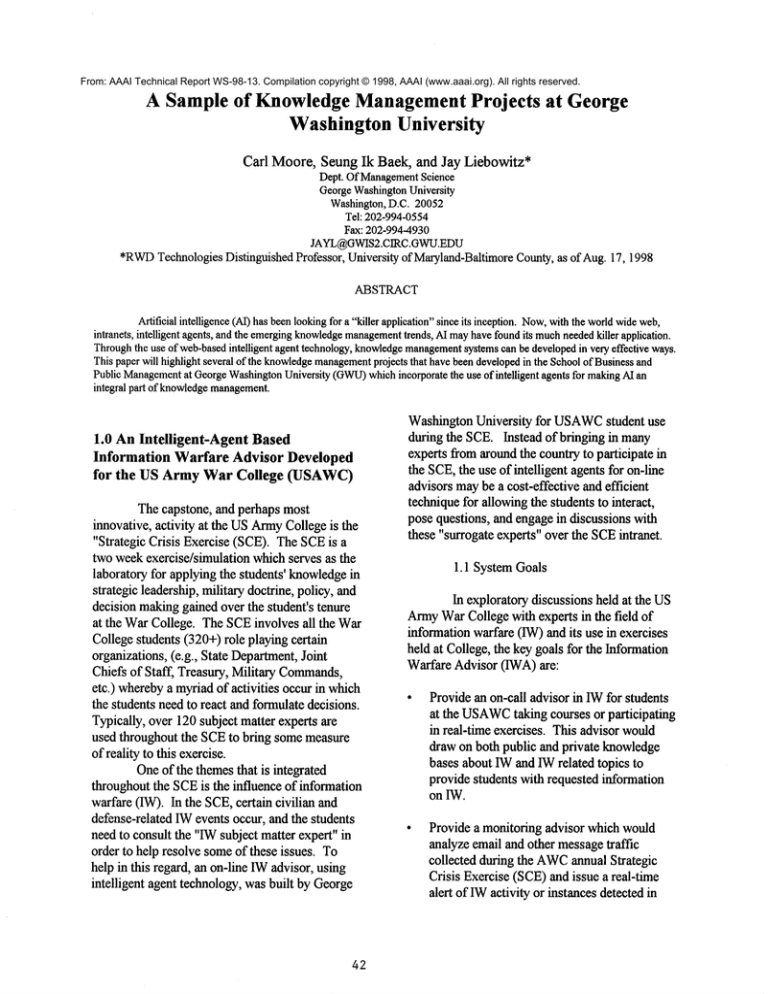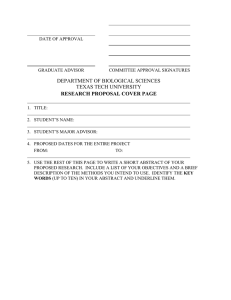
From: AAAI Technical Report WS-98-13. Compilation copyright © 1998, AAAI (www.aaai.org). All rights reserved.
A Sample of KnowledgeManagementProjects at George
WashingtonUniversity
Carl Moore, Seung Ik Baek, and Jay Liebowitz*
Dept. Of ManagementScience
George WashingtonUniversity
Washington, D.C. 20052
Tel: 202-994-0554
Fax: 202-994-4930
JAYL@GWIS2.CIRC.GWU.EDU
*RWD
TechnologiesDistinguishedProfessor, Universityof Maryland-Baltimore
County,as of Aug.17, 1998
ABSTRACT
Artificial intelligence (A_r) has beenlookingfor a "killer applieation" since its ineeption. Now,with the worldwideweb,
intranets, intelligent agents, and the emergingknowledgemanagement
trends, AI mayhavefound its muchneededkiller application.
Throughthe use of web-basedintelligent agent technology, knowledgemanagement
systems ean be developedin very effeetive ways.
This paper will highlight several of the knowledgemanagement
projects that have been developedin the Sehoolof Business and
Public Management
at GeorgeWashingtonUniversity (GWU)
whieh incorporate the use of intelligent agents for makingAI
integral part of knowledgemanagement.
1.0 An Intelligent-Agent Based
Information Warfare Advisor Developed
for the US Army War College (USAWC)
The capstone, and perhaps most
innovative, activity at the USArmyCollegeis the
"Strategic Crisis Exercise (SCE). The SCEis
two weekexercise/simulation whichserves as the
laboratory for applying the students’ knowledgein
strategic leadership,military doctrine, policy, and
decision makinggained over the student’s tenure
at the WarCollege. The SCEinvolves all the War
Collegestudents (320+)role playing certain
organizations, (e.g., State Department,Joint
Chiefs of Staff, Treasury, Military Commands,
etc.) wherebya myriadof activities occur in which
the students needto react and formulatedecisions.
Typically, over 120 subject matter experts are
used throughout the SCEto bring somemeasure
of reality to this exercise.
Oneof the themesthat is integrated
throughoutthe SCEis the influence of information
warfare (IW). In the SCE,certain civilian and
defense-related IWevents occur, and the students
needto consult the "IWsubject matter expert" in
order to help resolve someof these issues. To
help in this regard, an on-line IWadvisor, using
intelligent agent technology,wasbuilt by George
42
WashingtonUniversity for USAWC
student use
during the SCE.Instead of bringing in many
experts fromaroundthe country to participate in
the SCE,the use of intelligent agents for on-line
advisors maybe a cost-effective and efficient
techniquefor allowingthe students to interact,
pose questions, and engagein discussions with
these "surrogate experts" over the SCEintranet.
1.1 SystemGoals
In exploratorydiscussions held at the US
ArmyWarCollege with experts in the field of
informationwarfare (IW)and its use in exercises
held at College, the key goals for the Information
Warfare Advisor (IWA)are:
Providean on-call advisor in IWfor students
at the USAWC
taking courses or participating
in real-time exercises. This advisor would
draw on both public and private knowledge
bases about 1Wand IWrelated topics to
provide students with requested information
on IW.
Provide a monitoring advisor whichwould
analyze email and other messagetraffic
collected during the AWC
annual Strategic
Crisis Exercise (SCE)and issue a real-time
alert of IWactivity or instances detectedin
the email or messagethreads. This alert
wouldbe part of the SCEsimulations.
Provide an assessment advisor whichwould
analyze email threads and other message
traffic collected during the USAWC
annual
SCEand developa post exercise set of cases
on the lW activity during the SCE.These
cases wouldbe used to de-brief students after
the exercise, designfuture exercises, as well
as add to the IWAknowledgebase on IW.
Theinitial research project focusedonly
on developinga portion of the IWAas a proof of
conceptdemonstrator.Initially, a limited scope
advisor agent system was developed, providing
the user callable advisor capability for students at
the USAWC.
The on-call advisor advises
students on a limited numberof topics via the user
agent, a single brokeragent, and one or two
specialist agents in selected IWtopics.
The computingenvironmentin whichthe
IWAoperates is a heterogeneousnetwork of
server and client computers.Theservers are a
mix of Sun workstations and WindowsNTservers
used as mail, file, andwebservers. Theclients are
end-user workstationsconsisting of mostlyIntel
486 and Pentiumclass desktop or laptop PCS.
All servers and clients are networkedusing 10
MbpsEthernet and the TCP/IPprotocol. The
Relational Database ManagementSystem
(RDBMS)
installed is the Oracle system. The
networkis set-up as a private intranet. Thereis no
external accessto the Internet at this time,
althoughsuch access is held out as a future
potential and mustbe accountedfor in the
architecture for expansion.
The IWknowledge bases which the 1WA
uses are a combinationof existing legacy
knowledgebases and databases, as well as new
knowledgebases created as part of this research
effort and subsequentdevelopmentefforts for the
IWA.These knowledgebases and databases are
distributed throughout the computing
environment,residing on different servers.
1.2 General Approach
Thedistributed nature of the knowledge
bases in the IWAenvironmentled to the decision
43
to base the IWAconceptual architecture on a
distributed AI approachusing a collection of
cooperatingintelligent agents. This approach
offers both several advantages,as well as certain
disadvantages. Howeverit was felt the
advantagesof this approach,in lieu of developing
a single monolithicexpert system advisor, more
than outweighedthe disadvantages.
The multi-agent approachis a more
complexdesign, and consequently was more
difficult to implementthan the monolithic
approach. Howeverthe multi-agent approachis
better suited to the distributed environment
for the
IWA.A multi-agent system allows better shared
use of the computingresources available on the
networkfor load leveling, andavoids the potential
bottleneckof a single point of accessfor the
advisor. Themulti-agentsystemis also easily
extendedby addingagents with different
specialties. In this mannerthe capability of the
overall IWAsystem can be increased by re-using
the developedagent architectures over and over,
but each time with a different knowledgebase.
1.3 ConceptualArchitecture--Brokered
Agents
Thebrokeragents in this architecture act
as generalists in their field. Eachbrokermaintains
knowledgeof specialist agents in the environment
whichhad problemsolution capabilities within the
broker’s general domain.Other agents seeking
assistance with a problemthen need only to
contact the brokers to receive informationon what
specific agents wouldbe of assistance, and then
contact those agents only, rather than placing a
universal query. Optionally, the system could be
devised so that the problemcould be divided into
larger pieces by the originating agent and passed
to the brokers. Thebrokers wouldthen handle the
job of further breakingdownthe portion of the
problemwithin their owndomain,using domain
specific knowledgeabout problemsolving, contact
the agents within their brokeragefor solutions,
synthesizetheir portions and handoff to the
originating agent. Theoriginating agent would
then synthesize the partial answersfroma few
brokers rather than from a larger numberof
specialists. This secondvariant of the broker
process, using the brokers as domaingeneralist for
sub-problemplanning and solution through
subcontractingto specialists is the approachused
for the IWA.The broker concept of a cooperative
systemof agents is called an agency.
The conceptual process of problem
solution in a brokeredagencysystembegins with
a user presenting a problemto the systemfor
solution. Thepresentation of the problemis via a
user agent. Theuser agent consists of both a user
interface as well as the underlyinglogic and
reasoningability to break the probleminto
portions and pass those portions to a brokeror
brokers for solution. This passing of problem
portions is termed subcontracting. Underthe
terms of the subcontract the user agent would
request assistance, and the broker wouldaccept
the problem.In the event no broker was able to
solve the problemportion, or no agent was
available, then no subcontract wouldbe madeand
the user is notified of the failure to perform.
If the brokercan solve the problem,then
the broker wouldbreak the subcontract into
portions for solution by the specialist agents
within its domain.Eachspecialist agent could
proceedindependently,or in conjunctionwith
other agents, to solve the problem.There is no
restriction on specialist agents possessingthe
sameability as the user agent to subcontractparts
of its assignedproblemto other agents througha
broker, either the sameor a different broker.
Thespecialist agents also have access to
both private databases and knowledgebases of
their own,as well as public databases and
knowledgebases accessible by all specialist
agents. These public databases and knowledge
bases maybe legacy databases madeavailable to
the populationof agents in a standard format
wrapperagent. Thejob of the wrapperagent is to
act as a translator for the systemfromthe unique
format and structure of the legacy databaseto the
general structure and format used by the agent
system.
The brokered agency conceptual
architecture has advantagesand disadvantages.
Maintenanceand expansion are moredifficult
since new agents must be somehow
registered
with one or morebroker agents so the brokers
knowthey exist and whattheir capabilities are. In
like manner,newbroker agents must also be made
knownto the user agent. This registration can be
mademanualat the time of adding or updating
agents, increasing the load on maintenance
programmers,or can be madeautomatic through
logic includedin the designof the agent
architecture. However
this increases the load on
the agent developers,and indirectly on the
maintenanceprogrammerssince nowthe agent
designs would be more complexand hence more
costly to maintain.
However,there are a numberof key
advantagesoffered by the brokered agency
architecture that outweighthe disadvantages. With
a brokeragecooperative agreements,or subcontracts, communicationamongthe agents is
easier to establish. Thebrokerageconcept reduces
sharply the numberof other agents a user agent
must be awareof in order to process a problem.
Eachbrokeracts as a generalist in its domain,
providinga source of informationon the specific
agents whichcan be of assistance, or actually
taking on the sub-task itself for solution. Brokers
can also call uponother brokers, not just the
specialist agents within its domain,thereby
wideningits field of expertise, as well as
providing the system with a hierarchy of domain
knowledge. Somebrokers would have more
general knowledgethan others, each level of
broker breaking the probleminto sub-tasks for
subcontractingto other morespecific brokers or to
specialist agents. This structure providesthe
systemwith a large degree of modularity, making
expansioneasier to plan, execute, test, and
manage.
Theadvantagesoffered by the brokered
agencyconceptweresufficient to warrant its
adoptionas the conceptualarchitecture of choice
for the IWAproject.
2.0 A Web-Based, Intelligent Agent
Approach for Managing Knowledge
Relating to Storyboard Development for
Multimedia Designers in a Virtual Setting
Another GWUknowledge management
project that used AI/intelligent agent technology
involved web-basedaccess for jointly developing
a storyboardfor a multimediaeffort. In this
context, knowledgemanagement
is a methodfor
systematically and actively managingand
44
leveraging ideas and design decisions amongteam
memberswhile developing storyboards. This
research involved developing a knowledge
managementsystem to help multimedia team
designers create, exchange,and share their
storyboards(the storyboardis the
script/thread/flowof activities relating to a
multimediaproject).
Therewerethree intelligent agents usedin
this knowledgemanagement
architecture. These
agents were created using Javascript, HTML,
and
CFML(Cold Fusion MarkupLanguage). The
knowledgecreating activity was handledby the
user agent whichremembered
all user activities,
and dynamicallyorganized a person’s agenda.
The knowledgesecuring activity was handled by
the knowledgeagent to index knowledge,detect
inconsistencies and generate recommendations,
and save/retrieve/update knowledge.The
knowledge
distributing and retrieving activities
were performed by the knowledgemanagerto
monitorall changesthat occurred in a knowledge
repository and forwardthemto the user agent,
reformulate queries based on an ontology, and
dynamicallyretrieve annotations and generate
hyperlinks for them.
Thesethree agents have well-defined
goals and knowledgeto performtheir tasks (goaloriented). Theyperformtheir tasks without direct
humanintervention (autonomousand selfstarting). Theagents interact with each other to
performtheir tasks (cooperative). The agents
interact with a user database, annotationdatabase,
and storyboard database.
Throughthis architecture, the multimedia
designers used in the research studies could
effectively and efficiently developtheir
storyboardsin a collaborative fashion via the web
in a virtual setting.
3.0
Summary
In order for knowledgemanagement
to
succeed,AI technologies(like intelligent agents)
are critical to the mainknowledgemanagement
functionsof creating, securing, capturing,
combining,distributing, and retrieving knowledge.
Thetwo projects briefly describedin this paper
highlight someof the workin whichAI can
45
greatly contribute to knowledgemanagement
systems and activities. At GWU,
weare
furthering our workin this area by also examining
performanceand learning amongintelligent agents
for developing improved knowledgemanagement
systems. Lastly, weare looking at developinga
methodology
for valuating intellectual capital
(particularly, humancapital) in an organization.
Selected References
Liebowitz, J. (ed.), The Handbook
of Applied
Expert Systems, CRCPress, Boca Raton, 1998.
Liebowitz, J. and T. Beckman,Knowledge
Organizations: WhatEvery ManagerNeeds to
Know,St. Lucie Press/CRCPress, Boca Raton,
1998.
Liebowitz, J. and L. Wilcox(eds.), Knowledge
Management
and Its Integrative Elements, CRC
Press, Boca Raton, 1997.

